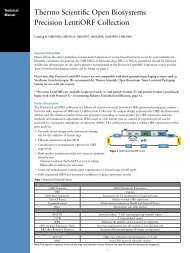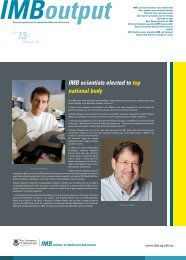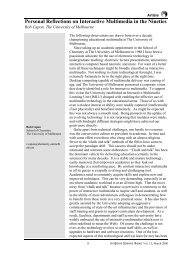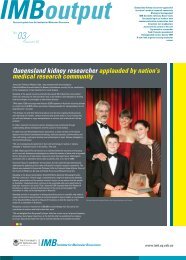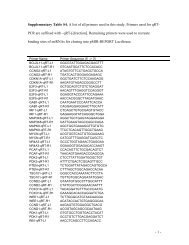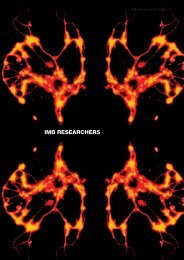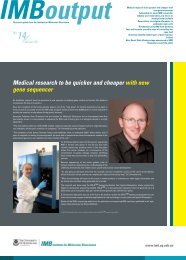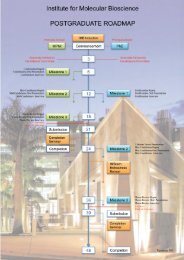2010 Annual Report - Institute for Molecular Bioscience - University ...
2010 Annual Report - Institute for Molecular Bioscience - University ...
2010 Annual Report - Institute for Molecular Bioscience - University ...
You also want an ePaper? Increase the reach of your titles
YUMPU automatically turns print PDFs into web optimized ePapers that Google loves.
imb annual report <strong>2010</strong><br />
48<br />
MIKE WATERS<br />
ROLE OF GROWTH HORMONE AND RELATED<br />
CYTOKINES IN GROWTH, CANCER, DIABETES<br />
AND OBESITY<br />
ADULT HEIGHT IS DETERMINED BY<br />
the actions of growth hormone (GH) during<br />
childhood and adolescence. In the adult,<br />
growth hormone is an important metabolic<br />
agent regulating body composition,<br />
opposing the actions of insulin. In old<br />
age, growth hormone status determines<br />
lifespan, at least in animal models. We<br />
study the means used by growth hormone<br />
to achieve these changes, using a variety<br />
of approaches directed to the growth<br />
hormone receptor, from high-resolution<br />
protein structures to genetically-engineered<br />
animals.<br />
The growth hormone receptor determines<br />
the degree of the cell response to growth<br />
hormone, which we originally cloned<br />
collaboratively with Genentech. Through<br />
FRET, BRET, crystallography and targeted<br />
mutagenesis we have developed a new<br />
model of how the GH receptor is activated<br />
by GH, involving realignment of receptor<br />
subunits within a constitutive dimer. An<br />
extension of this model describes how a<br />
rearrangement of an extracellular b-loop<br />
of the GH receptor selectively controls<br />
ERK activation without influencing Stat5<br />
activation through the use of an alternate:<br />
Src kinase.<br />
By creating targeted knock-in mutations to<br />
signalling domains within the GH receptor<br />
cytoplasmic domain, we have shown that<br />
enhancement of postnatal somatic growth<br />
by GH is dependent on its ability to activate<br />
the transcription factor Stat5. Because<br />
these mice become strikingly obese<br />
after 6 months of age, we are currently<br />
investigating the role of Stat5a/b in control<br />
of lipid and carbohydrate metabolism using<br />
tissue-targeted gene deletion of Stat5a/b.<br />
We have found that insulin secretion and<br />
action are altered in these mice, and<br />
their livers are grossly steatotic. We are<br />
identifying the molecular targets of GH that<br />
regulate these changes, using in vivo Cre<br />
deletion of key transcription factors.<br />
The surprising finding that the growth<br />
hormone receptor is located in the cell<br />
nucleus of dividing cells has led us to<br />
discover that nuclear localised receptor<br />
induces the expression of a key stem cell<br />
marker. Because we have shown that GH<br />
promotes neural stem cell proliferation, we<br />
are studying the mechanism of this direct<br />
gene induction by the GH receptor.<br />
The absolute requirement <strong>for</strong> GH in liver<br />
regeneration has led us to use our panel of<br />
GH receptor signalling mutants to find the<br />
identity of the regeneration signal.<br />
RESEARCH PROJECTS<br />
• Investigating the mechanism of<br />
activation of growth hormone and<br />
related cytokine receptors, including<br />
the mechanism of activation of the<br />
Src kinase constitutively bound to the<br />
receptor<br />
• Elucidating the role of the growth<br />
hormone receptor in the cell nucleus<br />
in relation to proliferation, oncogenesis<br />
and stem cell proliferation<br />
• Determining the role of GH-dependent<br />
Stats 5/3/1 in lipid and carbohydrate<br />
metabolism, including insulin action<br />
• Establishing the molecular basis <strong>for</strong><br />
GH-dependent liver regeneration<br />
• Establishing the molecular mechanism<br />
underlying the long-term activation of<br />
neural stem cells by GH<br />
KEY PUBLICATIONS<br />
Blackmore, D.G., Golmohammadi, M.G.,<br />
Large, B., Waters, M.J., and Rietze, R.L.<br />
(2009). Exercise increases neural stem cell<br />
number in a growth hormone-dependent<br />
manner, augmenting the regenerative<br />
response in aged mice. Stem Cells 27:<br />
2044-2052.<br />
Conway-Campbell, B.L., Brooks, A.J.,<br />
Robinson, P.J., Perani, M., and Waters,<br />
M.J. (2008). The extracellular domain of<br />
the growth hormone receptor interacts<br />
with coactivator activator to promote cell<br />
proliferation. <strong>Molecular</strong> Endocrinology 22:<br />
2190-2202.<br />
Lichanska, A.M., and Waters, M.J. (2008).<br />
How growth hormone controls growth,<br />
obesity and sexual dimorphism. Trends in<br />
Genetics 24: 41-47.<br />
Rowlinson, S.W., Yoshizato, H., Barclay,<br />
J.L., Brooks, A.J., Behncken, S.N., Kerr,<br />
L.M., Millard, K., Palethorpe, K., Nielsen,<br />
K., Clyde-Smith, J., Hancock, J.F., and<br />
Waters, M.J. (2008). An agonist-induced<br />
con<strong>for</strong>mational change in the growth<br />
hormone receptor determines the choice<br />
of signalling pathway. Nature Cell Biology<br />
10: 740-747.<br />
Schirra, H.J., Anderson, C.G., Wilson,<br />
W.J., Kerr, L., Craik, D.J., Waters,<br />
M.J., and Lichanska, A.M. (2008).<br />
Altered metabolism of growth hormone<br />
receptor mutant mice: a combined NMR<br />
metabonomics and microarray study.<br />
PLoS ONE 3: e2764.<br />
LAB MEMBERS<br />
Research Officers: Dr Andrew Brooks, Dr<br />
Tim McPhee<br />
Research Assistants: Kathryn Tunny,<br />
Tania Brooks<br />
PhD Students: Caroline Nelson, Yash<br />
Chhabra<br />
Masters Student: Qiushi Chen<br />
Occupational Trainee: Morgane Roussel<br />
Human melanoma line infected with mKATE2<br />
expressing chicken virus, demonstrating ability<br />
to deliver STAT5 dominant negative to halt<br />
metastasis.




